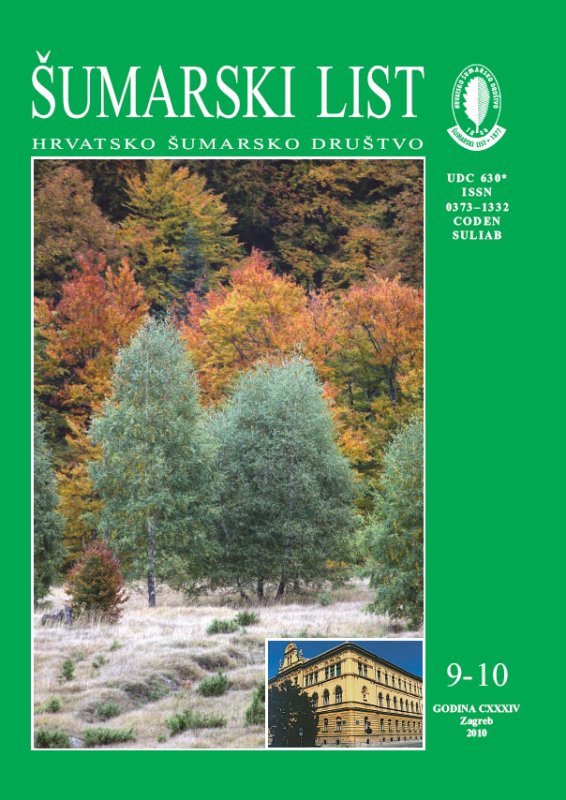| |
| RIJEČ GLAVNOGA UREDNIKA |
| |
|
|
| Branimir Prpić | |
| THE NEW FOREST LAW
pdf
HR
EN
|
445 |
| |
| IZVORNI ZNANSTVENI ČLANCI |
| |
|
|
| Pandža,M., V.Krpina | UDK 630* 187 + 188 (001) |
| Forest Vegetation of the Island of Vrgada and its Islets (Dalmatia, Croatia)
pdf
HR
EN
|
447 |
| Pejnović,D., K.Krapinec, M.Slamar | UDK 630* 156 (001) |
| Hunters in Croatia as a Socio-Geographic Group and their Socio-Demographic Characteristics
pdf
HR
EN
|
461 |
| Šerić Jelaska, L., A. Ješovnik, S. D. Jelaska, A. Pirnat, M. Kučinić, P. Durbešić | UDK 630* 114.6 + 411 (001) |
| Variations of Carabid Beetle and Ant Assemblages, and their Morpho-ecological Traits within Natural Temperate Forests in Medvednica Nature Park
pdf
HR
EN
|
475 |
| Čas, Miran | UDK 630* 156 (001) |
| Disturbances and Predation on Capercaillie at Leks in Alps and Dinaric Mountains
pdf
HR
EN
|
487 |
Abstract:Capercaillie (Tetrao urogallusL.) populations in central and south-east Europe cover fragmented edge habitats and are recorded to decline since 1960ies. Capercaillie leks in Slovenia are present at the south-eastern edge of the Alpine metapopulation and at north-western edge of Dinaric. These populations were monitored at leks in two periods in 1980 (466 monitored leks) and 2000 (599). All leks were monitored by local specialists (hunters and/or foresters) and main causes of observed lek populations decline were addressed to each endangered lek. Special emphasis was given to predation at leks, as suggested by D. Jenkins (2008). The six named reasons in 1980ies affected 39 leks with logging of old-growth forests (at 71.8% of leks) and construction of forest roads (7.7%) as most pronounced. In 2000 nine reasons affected 92 leks: (i) mountain tourism (26.1%), (ii) cutting of old-growth forests (19.60%), (iii) predators attacks (18.5%), (iv) forest management in spring time (9.8%), (v) pastures of livestock with wire fences in forests (6.5%), (vi and vii) berries picking and overgrowing the last pastures in forest-landscape, (viii) constructions of forest roads and (ix) infrastructure. The most profound change in reasons between 1980 and 2000 mapping data were: predation at leks, mountain tourism development, increasing of forest management in spring time, wild pasturage of cattle and sheep in forests, overgrowing the last pastures in forest-landscape. A comparison of the increasing percentage of leks endangered by predators since 1980 has shown positive correlations with increasing of the main predator populations’ densities. Population density of martens (Martessp.) and wild boar (Sus scrofa) increased for 150% since 1980, while red fox (Vulpes vulpes) density increased only after 1990. Our results confirmed the assessment of reasons for threats to leks based on descriptions and experiences of observers as a suitable approach for capercaillie habitat risk assessment. Results for past decline and differences regarding to the negative impacts on lek habitats are important guidelines for foresters and wildlife managers concerning sustainable forest management and maintenance of capercaillie populations.
Key words: Capercaillie (Tetrao urogallus); causes of leks endangerment; forest and wildlife management; mountain tourisms; predation; rare species population’s conservation |
| |
| PRETHODNO PRIOPĆENJE |
| |
|
|
| Matošević, D., M. Pernek, B. Hrašovec | UDK 630* 453 |
| First Record of Oriental Chestnut GallWasp (Dryocosmus kuriphilus) in Croatia
pdf
HR
EN
|
497 |
| |
| PREGLEDNI ČLANCI |
| |
|
|
| Tomićević, J., M. A. Shannon, D. Vuletić | UDK 630* 903 + 907.1 |
| Developing Local Capacity for Participatory Management of Protected Areas: The Case of Tara National Park
pdf
HR
EN
|
503 |



